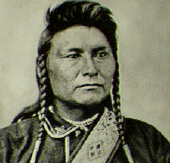- Nez Perce Indian History
"Nez Perce" is French for "pierced nose." While the Nez Perce did not traditionally pierce their noses, the name stuck just the same.
- Go to History Links
- Go to Nez Perce Links
"Nimi'ipu" is how the Nez Perces refer to themselves !
The Nez Perce originally lived in three of the most rugged river canyons in the Northwest--the canyons of Idaho's Clearwater, Salmon, and Snake Rivers. The Snake's Hells Canyon, with its staircase rapids rushing through a chasm deeper than that of the Grand Canyon, contains more than 112 pictographs left by the Nez Perce ancestors, in addition to well-worn trails down the canyon's steep walls. The Nez Perce also lived on the Oregon side of the canyon, in a valley in the shadow of the Wallowa Mountains. More than 75 Nez Perce village sites have been identified along the Snake and its tributaries. Some have been carbon-dated to 11,000 years, or about 500 generations; there are also indications of far older settlements.
The Treaty of 1855 ordered the Nez Perce to relinquish their ancestral territory and move to Oregon's Umatilla Reservation with the Walla Walla, Cayuse, and Umatilla Tribes. However, all the tribes so opposed this plan that Territorial Governor Isaac Stevens granted the Nez Perce the right to remain in their own territory, on the condition that they relinquish nearly 13 million acres to the U.S. government.
After gold and other metals were discovered in Nez Perce country, the U.S. government negotiated a new treaty with the tribe in the 1870s. Often called the "steal treaty," it stripped the Nez Perce of the Wallowa and Imnaha Valleys and the land at the confluence of the Snake and Clearwater Rivers--the site of the present-day towns of Lewiston and Clarkston.
- Chief Joseph
- 1800s Nez Perce History
- 1855 Blackfeet Treaty of Fort Benton -- also signed by the Nez Perce to secure their hunting rights East of the Rockies
- 1855 Treaty of Camp Stevens
- 1863 Treaty of Lapwai
- 1868 Third Nez Perce Treaty
- 1873 Executive Order establishing Wallowa Reservation -- there was a later order which rescinded this
- 1877 Nez Perce War--Flight of the Nez Perce
- 1895 Proclamation regarding Nez Perce Reservation
- Nee-Me-Poo Trail
- Nez Perce Indians--Online Highways
- Nez Perce National Forest--Online Highways
- Nez Perce National Historic Park
- Nez Perce National Historic Trail Foundation
- White Bird Hill Battlefield
Nez Perce Links
- Darlene Gadley's Genealogy Page -- includes Nez Perce research and an on-line copy of the 1890 census
- Official Nez Perce Home Page
- Nez Perce Horse Registry
- Nez Perce Tribal newspaper: Tots Tatoken, P.O. Box 365, Lapwai, ID 83540, 208-843-7403, FAX: 208-843-7378, e-mail: totst@nezperce.org -- contact them if you would like to subscribe to this
- Spalding-Allen Collection
- Spalding Allen Collection Index -- pictures of items in this wonderful collection
- WSU Museum of Art -- pictures from the beautiful exhibit "Song to the Creator"
- Nee-me-poo Home Page--This site was developed by three University of Idaho students to inform people about the Nez Perce culture.

 History
Links
History
Links
